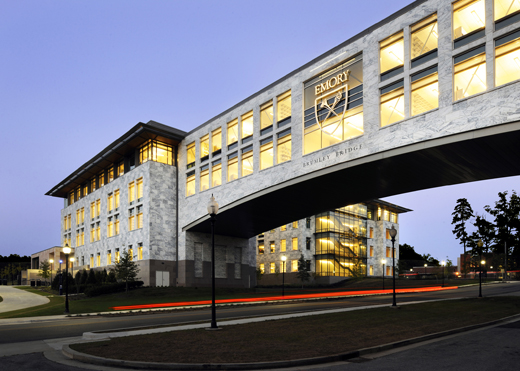Health Sciences Research Building dedication: Oct. 24, 2013, 10 a.m.
For more information, view the registration website.
A new five-story, 200,000-square-foot Health Sciences Research Building will be dedicated Thursday, Oct. 24 at Emory University. More than half the facility will be devoted to pediatric research through the Emory-Children's Pediatric Research Center, a partnership between the Department of Pediatrics in Emory University School of Medicine and Children's Healthcare of Atlanta. The research partnership also has key affiliates such as Georgia Institute of Technology.
"The dedication of this new building brings great hope for advancing health care for children and adults in Georgia and beyond, and is a manifestation of our successful partnerships with Children's Healthcare of Atlanta and with Georgia Tech in pediatrics and biomedical engineering," says S. Wright Caughman, MD, Emory executive vice president for health affairs and CEO of the Woodruff Health Sciences Center. "Together, our institutions can accomplish far more than each of us working alone, and we are extremely grateful for the support of our donors, who have given us this tremendous opportunity for even greater collaboration.”
The new building, located on Haygood Drive, has four stories above ground and one below. A two-story, 32-foot-wide, 173-foot-long working bridge crosses Haygood Drive and connects the building to the Emory-Children's Center building adjacent to Children's Healthcare of Atlanta at Egleston and the site of additional pediatric research and outpatient care. Named the Brumley Bridge in honor of George W. Brumley, Jr., former chair of the Emory Department of Pediatrics, it is the only occupied bridge in Atlanta.
"The Brumley Bridge unites research with clinical care and serves as a gateway from our community to Emory University and to Children's Healthcare of Atlanta. It symbolizes the important relationship between new advances in science and medicine and enhanced clinical care for children," says Donna Hyland, CEO, Children's. "Our scientists are helping to discover treatments and even potential cures that will impact kids in Atlanta, the children of Georgia, and ultimately, kids all over the world."
At the heart of the building's design is a simple idea: Make it easy for researchers to get fresh inspiration from talking to other scientists. In addition to the most advanced equipment and technology, the building's open design features natural light in laboratories and corridors, hallways with plenty of seating, a café dining area with indoor and outdoor seating, and an auditorium. At full capacity, the building will accommodate 75 lead researchers and their teams (500 people altogether).
"This building will bring together researchers from various disciplines who may think differently, in order to facilitate new ideas and new ways of thinking about a problem. That's what creates breakthroughs,” says David Stephens, MD, vice president for research in Emory's Woodruff Health Sciences Center and the Stephen W. Schwarzmann Distinguished Professor of Medicine.
In addition to childhood diseases, the new building will include cancer research led by the Winship Cancer Institute at Emory, drug discovery research conducted through the Emory Laboratory of Biochemical Pharmacology, and genetics research led by the Emory School of Medicine's Department of Human Genetics. Emory-based faculty in the Wallace H. Coulter Department of Biomedical Engineering at Georgia Tech and Emory University also have their research laboratories in the new building.
The building is encased in five shades of marble. It includes environmentally friendly features such as sensors that ramp down the heating system when the building is unoccupied, and built-in containers for composting and recycling. During demolition of an older dormitory and construction of the new building, 98 percent (18,500 tons) of all construction waste was recycled. The building is expected to be LEED-silver certified.
Architects ZGF (Zimmer Gunsul Frasca Architects LLP), designed the building, with Brasfield & Gorrie as general contractor.
The approximately $90 million cost of the building was funded entirely by philanthropic donors, including the Robert W. Woodruff Foundation; Joseph B. Whitehead Foundation; O. Wayne Rollins Foundation; Zeist Foundation; Martha and Wilton Looney Foundation; Katherine John Murphy Foundation; Luther and Susie Harrison Foundation; David, Helen and Marian Woodward Fund; the Georgia Research Alliance; Raymond Schinazi; Margaret Hirst Davis; James and Helen Carlos; and two anonymous donors.

